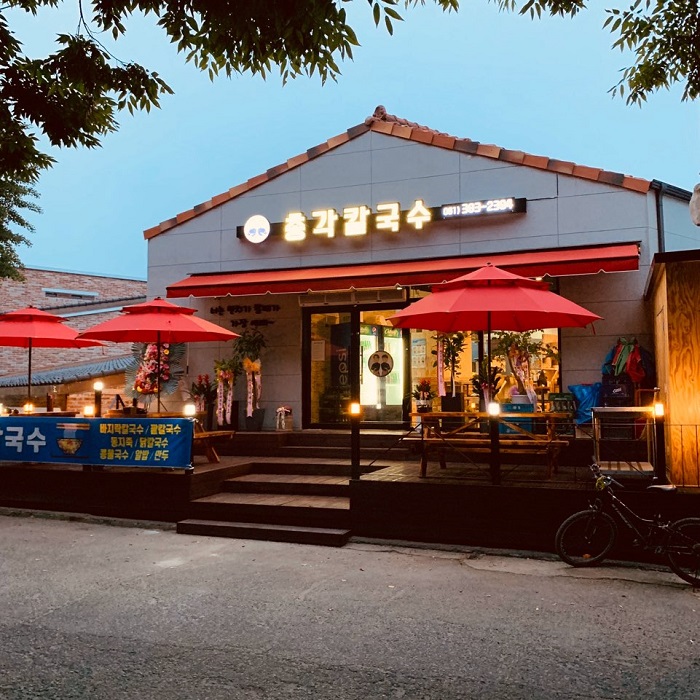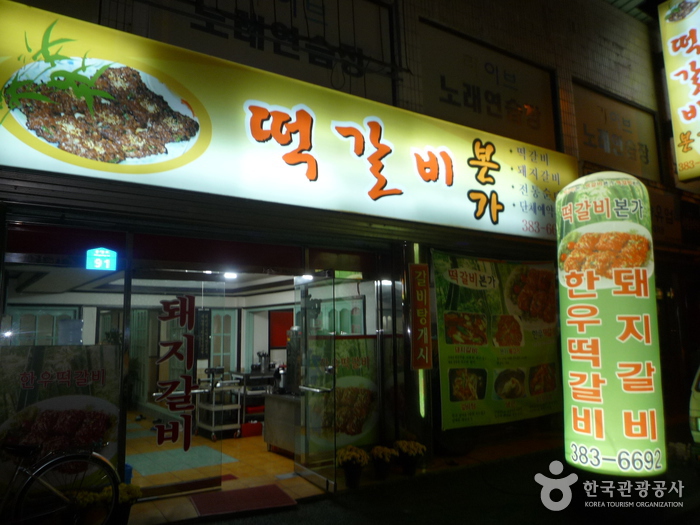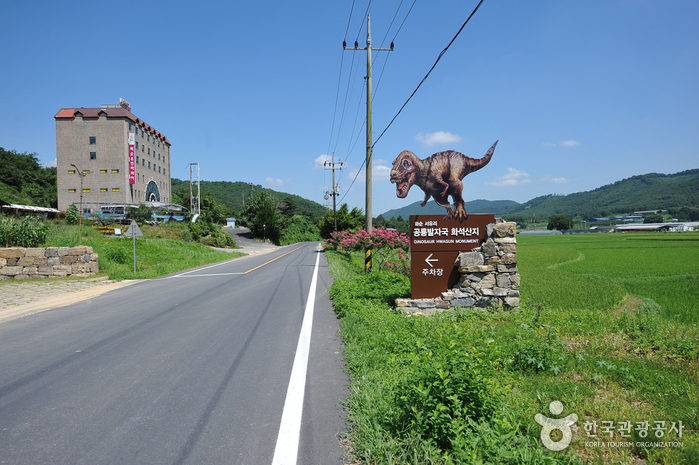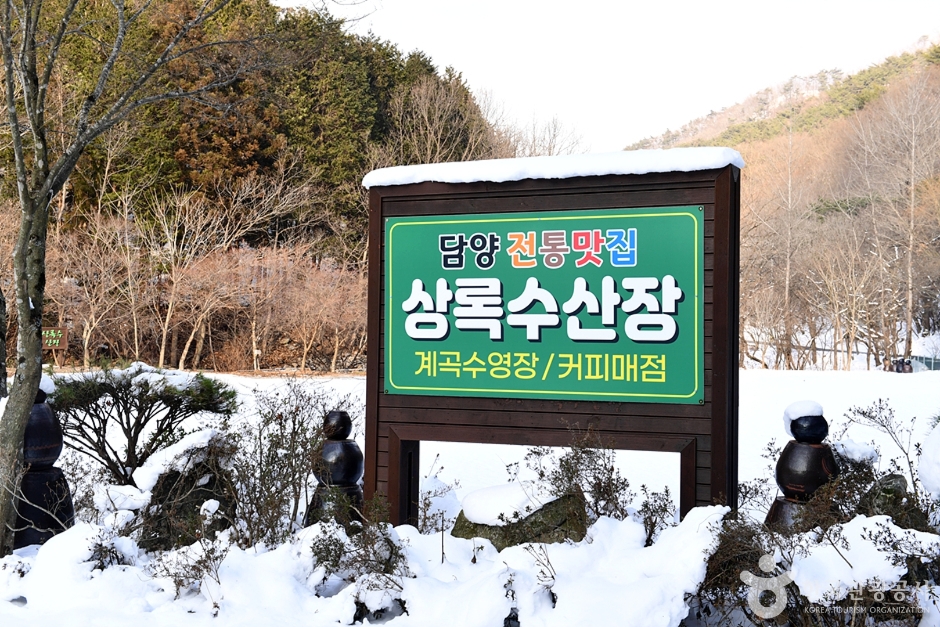Yeongsangang River Culture Pavilion (영산강문화관)
17.3Km 2020-06-09
90, Seungchonbo-gil, Nam-gu, Gwangju
+82-62-335-0866
With the slogan “Yeongsangang River, where Nature and Life Coexist,” Yeongsangang River Culture Pavilion consists of an open space that blends well with the surrounding natural environment. The center provides a variety of educational programs and hands-on events, through which visitors can increase their understanding of the Yeongsangang River restoration project, the history of Namdo region, and the cultural and ecological environment of the area.
Chonggak Kalguksu (총각칼국수)
17.4Km 2021-03-20
24-17, Damju 4-gil, Damyang-gun, Jeollanam-do
+82-61-383-2394
You can enjoy delicious noodles at reasonable prices. A noodle soup specialty restaurant located in Damyang-gun, Jeollanam-do. The most famous menu is noodle soup with clams.
Tteokgalbibonga Restaurant - Damyang Branch (떡갈비본가-담양)
17.4Km 2021-08-26
91, Jungang-ro, Damyang-eup, Damyang-gun, Jeollanam-do
+82-61-383-6692
Damyang, located in Jeollanam-do, is not only famous for its bamboo trees, but is also for its tteokgalbi, or grilled short rib patties.
Tteokgalbibonga, known for its signature tteokgalbi, has become quite famous in the area. With its exquisite resemblance to injeolmi (rice cakes coated with powdered soybeans) and the way it melts in your mouth, it’s no wonder Tteokgalbibonga attracts guests from as far as Japan.
Tteokgalbi gets its name from its resemblance to rice cakes, or tteok. In addition to its texture, its savory marinade brings out the meaty flavor of tteokgalbi.
Aside from their main dish, hanu (Korean beef) tteokgalbi, they also have dwaejigalbi, bulgogi, and galbi tang available, served with regular side dishes of a Korean set menu, even including a dessert. Tteokgalbibonga is often crowded with customers that you’ll likely have to wait in line if you visit for during the evening.
Sinsikdang (신식당)
17.4Km 2024-12-26
전라남도 담양군 담양읍 담주2길 18-13
061-382-9901
Established in 1932, this restaurant has been passed down through four generations. One of its unique qualities is making its own fermented soybeans, soy sauce, and red chili paste, giving its dishes a rich and deep flavor.
Gwanbangjerim Forest (관방제림)
17.8Km 2025-01-09
1, Gaeksa-ri, Damnyang-gun, Jeollanam-do
+82-61-380-2812
Located in Damyang, Jellanam-do, Gwanbangjerim Forest (Natural Monument) is a forest that was made along the banks of Damyangcheon Stream. The two-kilometer-long forest stretches from Dongjeong Village in Namsan-ri to Hwanggeum-ri, Subuk-myeon and Gangui-ri, Daejeon-myeon.
Gwanbangjerim Forest is a special manmade forest that was planted to prevent flooding along Damyangcheon Stream. It is comprised of large trees such as muku trees, zelkova trees, nettle trees, and cherry trees that are about 200 to 300 years old.
The forest’s beauty is so well known that it was even selected as “Korea’s Most Beautiful Forest” by the Korean Forest Services. Visitors enjoy this gorgeous natural getaway all year round, with many stopping by the forest Sculpture Park for pictures. Nearby attractions include the Jungnogwon Bamboo Garden and the Metasequoia-lined road.
Chojeom Stay [Korea Quality]스테이 초점[한국관광 품질인증]
17.8Km 2023-05-23
33-6 , Dangga-gil, Naju-si, Jeollanam-do
+82-10-4892-3473
Chojeom Stay is a hanok guesthouse in the innermost part of a small village in Naju, Jeollanam-do. The old house, which has been renovated, comprises a living room, kitchen, bedroom space and a raised-floor numaru where guests can enjoy a quiet hour while brewing tea. The spacious yard contains an outdoor fire place that creates a sentimental time, and an open-air tub where you can bathe in warm water while cool breezes rustle the trees. The outdoor shoes lined up by the side of the yard are somehow touching.
Jungnimwon Garden (죽림원가든)
17.9Km 2024-02-19
358 Gasan-gil, Wolsan-myeon, Damyang-gun, Jeollanam-do
061-383-1292
Jungnimwon Garden offers traditional Korean flavors in a unique setting. Their signature dish is the Daetongyongjjim (Bamboo-steamed set menu), where various ingredients are steamed together in a long bamboo tube. This dish includes a variety of items such as Korean beef bulgogi, spicy braised chicken, prawn, grilled pork galbi, octopus, abalone, ray, yellow croaker, eggs, and rice served in the bamboo tube. Additionally, their daetongbap jeongsik (steamed rice in bamboo set menu) and hanu tteokgalbi (grilled Korean beef galbi patties) are also highly recommended.
Dinosaur Tracksite of Hwasun, Seoyu-ri (화순 서유리 공룡발자국화석 산지)
17.9Km 2020-02-25
2080, Baega-ro, Hwasun-gun, Jeollanam-do
The Dinosaur Tracksite of Hwasun was discovered in 1999 during a land survery for the construction of Hwasun Hot Springs Area. Most dinosaur tracks found in Korea are located in coastal areas in cities like Haenam and Boseong, so the discovery in the inner region of Jeollanam-do was a first. Most prints here come from carnivorous dinaosaurs of the Cretaceous period. The site is famous for there being tracks from no fewer than five different dinosaurs, as well as for being one of the longest trails and most direct examples of the exact movements of the dinosaurs. The tracks of one dinosaur are the longest in the world, stretching for 40 meters. Based on the foot size of 20-22 centimeters with a stride of approximately 90 centimeters, it is estimated that the prints were formed by a 4-5 meter tall Koolasuchus. In addition to the canivorous dinosaurs, tracks were found of 12 herbivorous dinosaurs, as well as fossilized plants. These plants offer much assistance in the research of herbivorous dinosaur diets.
Damyang Bamboo Festival (담양대나무축제)
18.0Km 2025-01-07
119 Jungnogwon-ro, Damyang-gun, Jeollanam-do
+82-61-380-3152
In Damyang, a town where bamboo grows abundantly, there used to be a day when villagers gathered to plant bamboo, known as the Day of Jukchwi (bamboo planting day). This tradition has evolved into an annual festival celebrated in May since the Goryeo Dynasty. The festival takes place around the famous bamboo forest, Juknokwon, and the natural monument forest, Gwanbangjerim Forest. Various bamboo-related activities are available, such as making bamboo kites, shooting bamboo water guns, and riding bamboo rafts and canoes. A stroll through the bamboo forest, which emits phytoncides and negative ions, offers a relaxing charm during the festival. Visitors can also enjoy Damyang’s local food on the lawns, watch performances, and participate in various events, immersing themselves in the celebration of Damyang and bamboo.
◎ Day of Bamboo Planting
May 13 on the lunar calendar is a good day to plant bamboo. It is recommended that bamboo shoots be planted during the rainy season, as bamboo loves water.
Sangnoksu Sanjang (상록수산장)
18.1Km 2024-02-19
378 Yongheungsa-gil, Wolsan-myeon, Damyang-gun, Jeollanam-do
Sangnoksu Sanjang is a restaurant located in the Yongheungsa Valley of Yonggusan Mountain in Damyang. Its signature menu is baeksuk (whole chicken soup). Visitors can enjoy this dish while dipping their feet in the cool waters of the valley during the summer, experiencing the unique Korean tradition of enjoying a healthy meal while refreshing oneself in the clear stream water and lush greenery of the forest.



![Chojeom Stay [Korea Quality]스테이 초점[한국관광 품질인증]](http://tong.visitkorea.or.kr/cms/resource/05/2949005_image2_1.jpg)



 English
English
 한국어
한국어 日本語
日本語 中文(简体)
中文(简体) Deutsch
Deutsch Français
Français Español
Español Русский
Русский